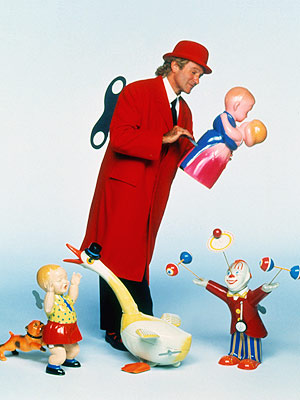“Toys” (1992)
November 17, 2008
Now here is a movie time forgot, isn’t it?
Toys (1992) seems to have fallen into obscurity after it’s brief success on VHS. After having seen it, I can certainly understand why. This unusual Robin Williams movie is both spectacular and puerile at the same time. It excels heavily in terms of art direction and sheer visual novelty. From what I understand, it was even nominated for an Oscar for the set design. At the same time, the plot is predictable and cheesy.
The Zevo family maintains a monumental toy factory far, far away from the rest of civilization. An innocent dreamland, you might say. The paternal figure in the family, Kenneth Zevo, is dying and needs to name a successor as the head of the company. The obvious choice is his son Leslie (Robin Williams), but Leslie is young and inexperienced. Instead, he names his brother, General Leland Zevo (Michael Gambon), his heir. While the general is a complete stranger to the toy business, he is much older and presumably wiser than Leslie. Not surprisingly, Kenneth dies soon after.
The general immediately decides to start producing war toys, which is unheard of in Zevo Toys. To avoid industrial espionage, he brings in his son Captain Patrick Zevo (LL Cool J), and has him maintain strict security. Leslie and his sister Alsatia (Joan Cusack) realize something is wrong. Over time, the general goes crazy and decides to convert the toy factory into a military weapons factory, with the idea that toy armies would be more efficient than regular ones. Obviously, Leslie and his entourage of toy factory employees must intervene and save the companies delightful innocence.
The overall plot of the film is a little childish and predictable. Every once and awhile there will be a worthy gag or joke to spice things up a little, but more often than not the jokes do little more than reveal the juvenile character of the factory employees. It is somehow appropiate that they are childlike, and it does give the film an unusual charm. However, the kiddy humor is excessive. The story is shoddy, and it isn’t the core concept at all. The problem is poor execution. They explain Gambon’s accent despite the fact that he is supposed to be an American, and the gag is even pretty funny. However, the relationship between Gambon and LL Cool J is very unconvincing. You’d think this was a children’s film, but then there is a creepy sex scene and a little innuendo. So what target audience is this movie intended for? The world may never know.
Some of the things that the film says about toys are interesting though, because some of it came true. At one point, the general brings in kids as test players for video games like first person shooters and flight simulators, and these types of games are popular now. Many games involve the over the top violence that desensitizes the youngsters in the general’s war rooms. At the time of the movie’s release, there certainly was already huge a shift to action figures like GI Joe’s.
While the plot is lackluster, the visual aesthetic is marvelous. The toy world is brilliantly conceived, and the look of this film is truly memorable. The inventive and animated environments are striking, as are the more unusual of Williams’ gadgets, such as a noisy jacket. My one of my favorite scenes is one where where Kenneth’s widow is adjusting a large, paper doll house, and the camera reveals that she herself is sheltered a life sized version of the same house. The effect on screen is interesting. It is the visual inventiveness in which this movies soul really lies.
While this is the most light-hearted, carefree film I have reviewed thus far, I believe it is also the weakest. Artistic beauty of this level is always welcome, but it is much more appreciable when the story is more refined. However, if you are in the mood for something peppy and not very demanding, this might be worth a gander.
5. 8



